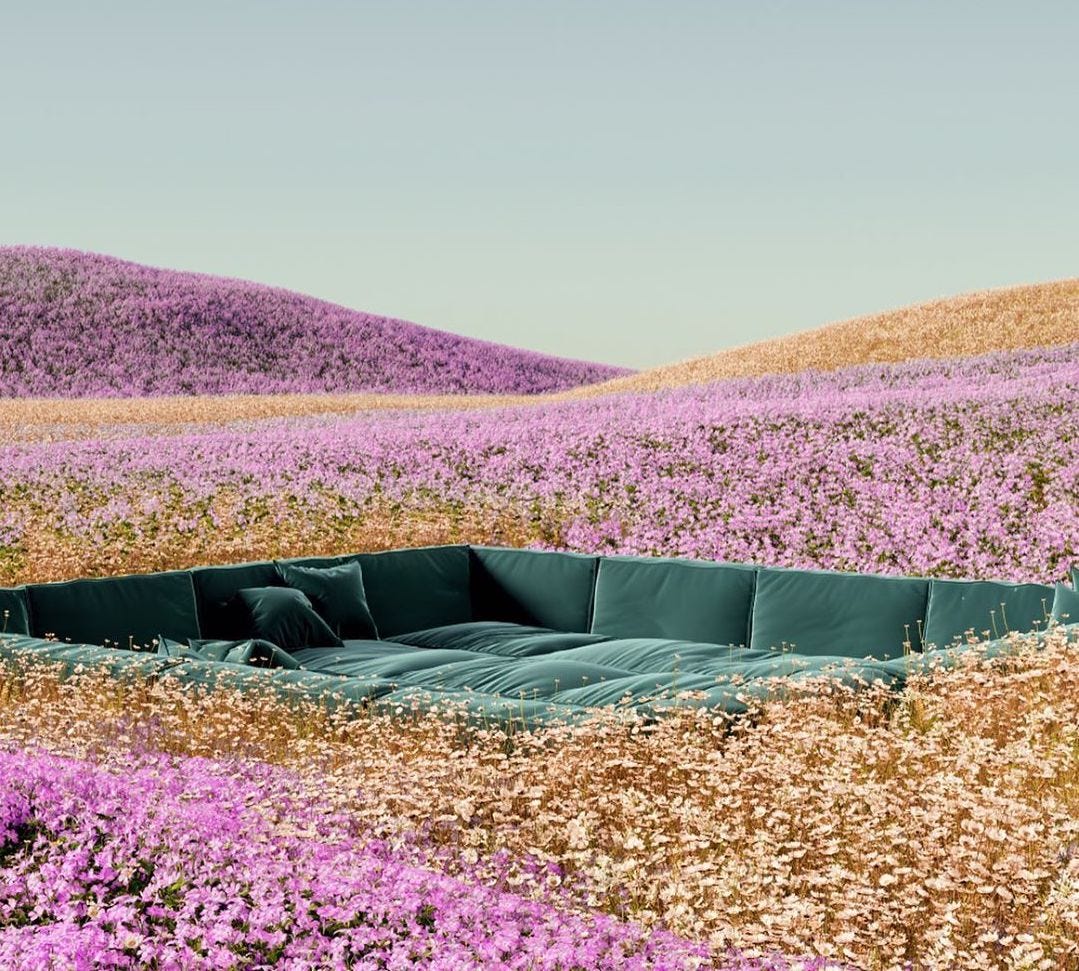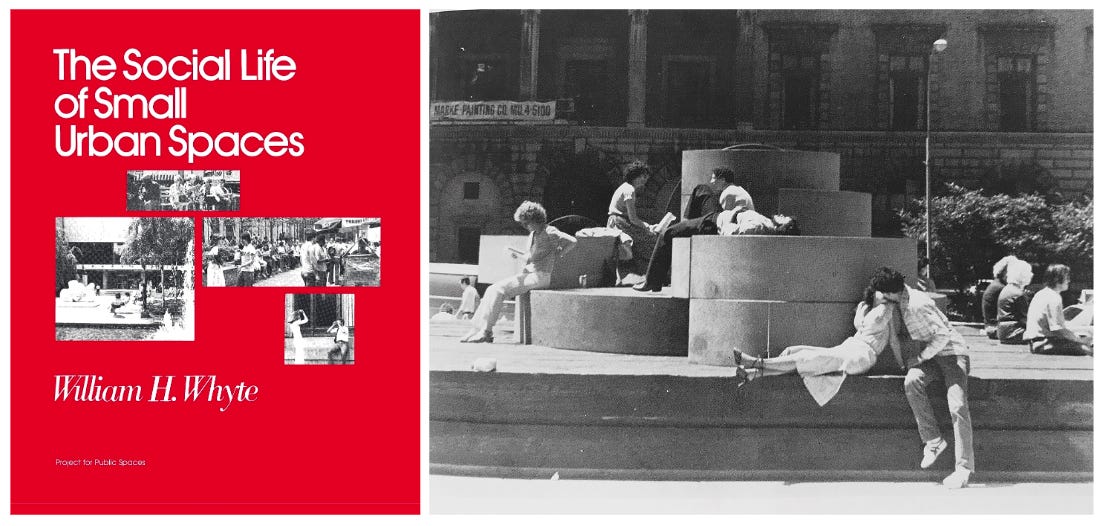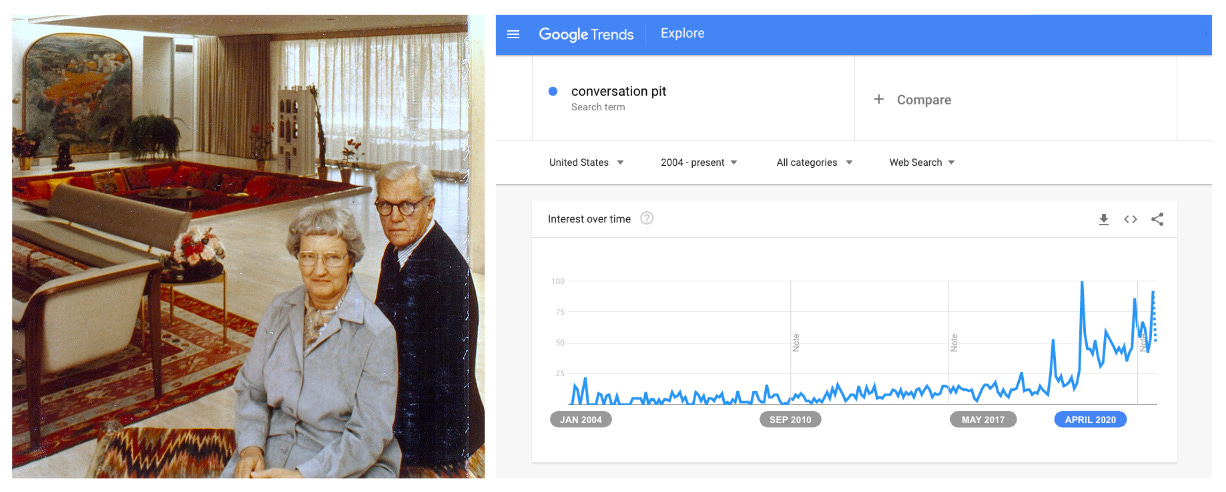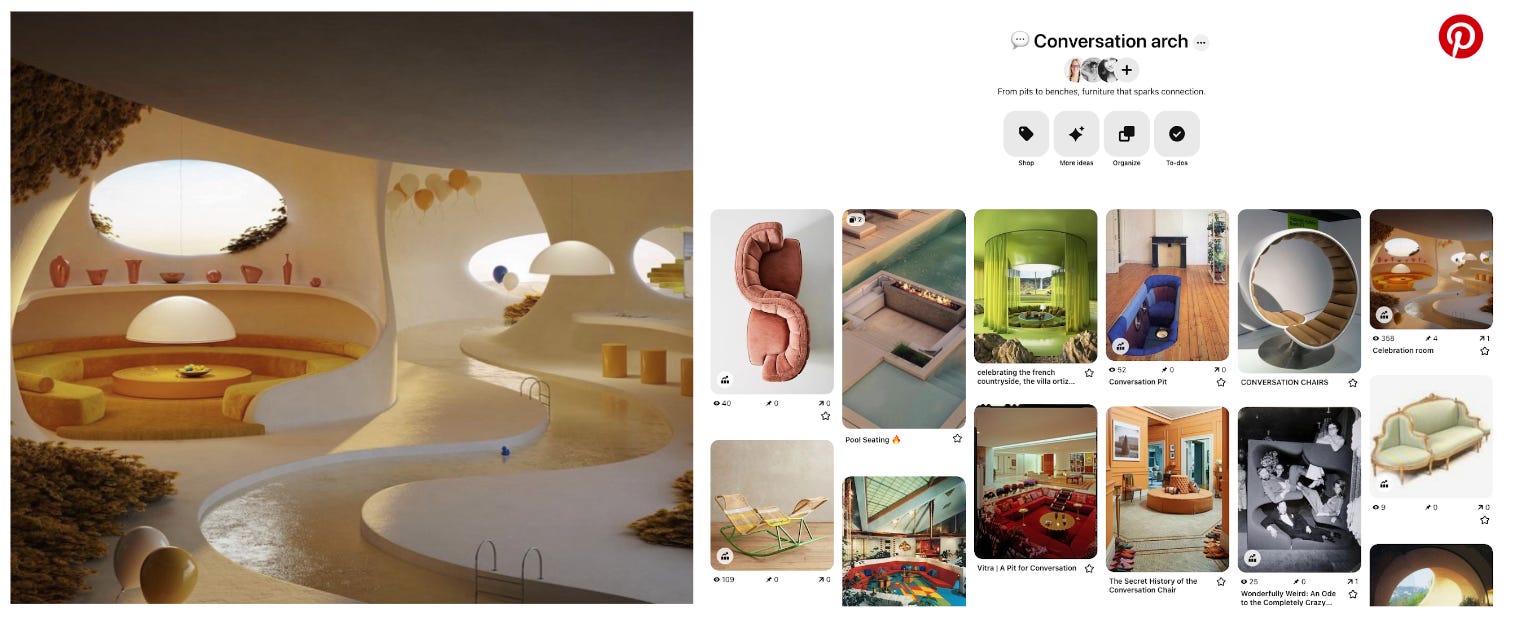In this week's newsletter, our design geek and New_ Public design sprint advisor, Melanie Kahl, continues our slow summer vibes theme with musings on communal seating.

We’re no stranger to learning from urban planning to create better digital public spaces and healthier social media platforms. In fact, we’ve been known to take it literally— looking to parks, libraries, and streetscapes to inform our collective imagination around what a new public internet might look like. As it becomes harder to hear our friends and family over the noisy superhighway of our various social media feeds, perhaps we need to zoom in to get a fresh perspective. William Whyte’s seminal “pre-book,” 'The Social Life of Small Urban Spaces,” suggests there’s beauty in starting small. In fact, that’s where Whyte begins his study— with how we sit and talk together.
Pull up a chair. Let’s see how communal furniture can inspire us to create a more intimate internet—from the quotidian to the quirky.

An oasis in the party: Vibes and why we love conversation pits
Conversation pits hit peak resurgence in April 2020 (yes, the shag-clad ‘sunken living room’ of the mid-century—ADA’s worst nightmare). On the one hand, the timing makes sense. Locked in our homes, stuck on phone calls and video conference calls, we would have given anything for a full-bodied gabfest in a conversation pit. Passing a canape and sharing the latest gossip at a buzzy house party was the furthest from our reality. We yearned for everything these pits embodied — relational intimacy and broader social connection. If Google search trends mean anything — it looks like this trend might stick around.

These islands of bustling human connection remind me of Whyte’s observations about “self-congestion” in city streets. Observing the behavior of congregating in the bustle of a city plaza, he mused:
“How many people would say they like to sit in the middle of a crowd? Instead, they speak of getting away from it all, and use terms like ‘escape,’ ‘oasis,’ ‘retreat.’ What people do, however, reveals a different priority…
In the center of a crowd, you have maximum choice—to break off, to continue—much as you have in the center of a good cocktail party, itself denser and denser.”
This is the tension we’re living in online right now. In our digital world, we’re trying to chat with our friends, family, and neighbors over the din of an increasingly crowded, commercialized algorithm. We’re craving places to hang out—whether it is “self-congesting” on a TikTok comment thread or hanging out on Discord.
“How can we create intimate, cozy spaces within the bustle of the internet?”

Our craving for these social nests has reached new heights—we’re even fantasizing about them. I was nearly duped by a particular dreamy series of conversation pits. Turns out, they were rendered. And not just for any client but for Facebook’s initiative to support Gen Z group leaders (Digital Locals). We’re seeking vibes— but I don’t necessarily think that means we want to be in a disembodied metaverse. We want to feel like we’re transported to transcendently cozy places. Places where we are deeply together. How might we foster this feeling (and functionality) digitally?
Getting geeky: Conversational affordances of tête-à-têtes & beyond
Conversation pits are just one example of social seating optimized for conversation. In true New_ Public fashion, as I went down a rabbit hole on the history of conversation furniture, I wondered how we might be inspired by it online. What are these bespoke pieces’ affordances? What can they tell us about creating intimacy in public?
For example, tête-à-tête settees, or lovers’ benches, are S-shaped chairs intended for a couple to discreetly and intimately interact while maintaining a level of Victorian modesty. What does their origin story tell us about the need for comfortable privacy in public, within boundaries?
A showpiece, the canapé à confidante,* is a sofa with two slightly angled seats at each end to enable polite conversational mixing ("an elegant drawing room...is scarcely complete without [one]"). What might it tell us about how people discreetly lean across multiple discussions?
Domestically, do we need to revive the gossip bench (aka telephone table) so our conversations online don’t replace face-to-face conversations at home? There are limits to extending furniture-driven metaphors (and certainly static design inspiration), but tangibility reminds us of basic human interactions.

Exercises in Civility: Choice, mobility, and the “sittability” of a place
Like any good design, it isn’t about the specifics of any furniture. It’s about people—what they do and need, and how we can best support healthy interaction. Whyte would heed caution—to architects and UX designers alike—of overdesigning. When we favor “artfully grouped…set pieces” over choice, we tread into the “design conceit” territory. Whyte muses:
“Now, a wonderful invention— the movable chair… Chairs enlarge choice: to move into the sun, out of it, to make room for groups, move away from them. The possibility of choice is as important as the exercise of it. If you know you can move where you want to, you feel more comfortable staying put.
…
Small moves say things to other people. …. A reciprocal move by one of the others may follow. Watching these exercises in civility is itself one of the pleasures of a good place.”
As you observe people gathering online and off, pay attention to how we sit together. Something tells me a blend of conversation pits and movable chairs can inform how we create intimacy, autonomy, and civility in the “small urban places” of the Internet. What we want in our online spaces is not that different from what we want from living rooms and plazas. We want to feel private, while keeping the pulse. We want to gently lean between conversations, while remaining present. We want choice. And, frankly, we want vibes.
Let us know what you're noticing in small urban spaces or the places you want to hang out at @WeAreNew_Public and @MelanieKahl. Or join us tomorrow, Tuesday, August 9th, at noon (ET) for this month’s Open Thread for even more geeking out on creating comfortable digital spaces for community conversations.
— Melanie Kahl
Melanie Kahl is a design collaborator, advisor, and facilitator at New_ Public. She believes in the power of community-driven design to change our communities—online and off. You can find her geeking out on Twitter, telling pedestrian stories on Instagram, or being a neighbor in Brooklyn. She thanks Tina, Holly, Alice, Deb, Angelica, Emily, & Christine for geeking out on conversation spaces.
I joining New_ Public to combine my passions for civic responsibility and technology
We’re excited to introduce you to the newest member of our team, Meagan Mitchell. Meagan joins us as our Chief of Staff with years of multidisciplinary experience in transformation strategy and visual design. She was most recently a co-director at Mobius, an organization working to enable the creation of liberatory technology. Read on for her introduction to the community, and please join us in welcoming her!
—
I joined New_ Public to combine my passions for civic responsibility and technology. I’ve spent my career working at the intersection of transformation strategy and visual design, using the tools of design thinking and systems thinking to envision what’s possible. So, I am especially appreciative of New_ Public’s mission of prototyping and building products to craft the future of healthy and benevolent tech spaces.
We are in the early stages as a society of understanding how to have a healthy relationship with technology. I’m acutely aware of the impact that technology – especially social media – has had on democracy and our overall sense of wellbeing. I firmly believe that we [society, all of us, New_ Public] have an opportunity and responsibility to determine what we want the future to look like. We can decide how we want to treat each other and what constitutes healthier digital spaces. A civil society desperately needs community to thrive, and technology can enhance our sense of community or chip away at it. The integration of technology’s role into our lives is here to stay; as a mom to two young children, I’m profoundly aware of this. Our challenge and mission are to think of how tech can be more of a utility for social good rather than only a center for profit. My primary focus is to leverage tech as a source of networking and communal uplifting as we rethink what digital spaces can look like.
We must ask ourselves, “How can we design and use technology to move us forward as a society and remind each other of our humanity?” That should be our North Star when designing digital structures.
I see New_ Public as a leader in helping all of us understand what's possible, and I am excited to be a part of making this work a reality.
You can reach me via email at meagan@newpublic.org or on Twitter at @meag_mitchell if you would like to connect.
— Meagan Mitchell
Community Corkboard
More Summer Beach Reads:
In an episode of the podcast UNDISTRACTED with Brittany Packnett Cunningham entitled “You Can Be Successful Where You Are: Majora Carter on Reclaiming Communities,” Majora Carter and Brittany Cunningham discuss the importance and empowerment of community and leveraging the presence of our current local societies to expand opportunity, amplify our diverse talents, and create collective equity.
Our #discuss Slack Channel was busy with lots of recommended links to add to our summer reading lists. Two of the items that stand out are Christopher M. Kelty’s exploration of participation and representative democracy, The Participant, in which he asks, “Why do we participate?” and sometimes, “Why do we refuse?” And Stephanie H. Murray’s article in The Atlantic about The Myth of Independent American Families, in which she poses, “in Nordic countries, people rely on the state. In the U.S., they rely on community.”
The Future of Belonging Newsletter: The newest edition of Vanessa Mason’s newsletter, The Future of Belonging, discusses her sentiments about the current “Age of Omnicrisis,” the “scarcity mindset,” and ways to pour into ourselves during such tumultuous times.
Unfinished Live: Mark your calendars! Next month, Unfinished is back with its annual Unfinished Live event to explore the crucial collaborations of technology, art, ideas, and democracy to shape and solidify the future of our society. The event takes place September 21-24 at The Shed in New York City. We are looking forward to learning from one another this fall! Register using our link for a special discount on your ticket.
Reader Survey - We want you to help us shape the future of our newsletter! There is still time to give us feedback on what you want to see in the coming months.
Contributing Writers: Your perspectives on building healthy digital public spaces have informed the way we think about building them, and we want to bring your viewpoints and ideas to our broader community. If you are interested in becoming a contributing writer in one of our upcoming issues, please fill out this form, and we will be in touch if we feel there is a fit!
Open Positions: Do prototyping, visual design, and innovation in infrastructure spark your excitement and creativity? We are hiring to recruit a Design Lead for our Community Lab! We have multiple positions open for brilliant minds that want to explore building digital spaces for public social good! Apply today!
The Community Corkboard is our place to help build awareness about all the exciting goings-on in the healthy digital spaces community. Do you have an upcoming event or happening you would like us to list on the Corkboard?
🪑🌳Pulling up a seat under a shade tree,
New_ Public is a partnership between the Center for Media Engagement at the University of Texas, Austin, and the National Conference on Citizenship, and was incubated by New America.




Good stuff Melanie! Reminds me of these chairs I saw in Mérida, Mexico: https://historicalmx.org/items/show/14
Love this piece! Especially: "We want to feel like we’re transported to transcendently cozy places. Places where we are deeply together. How might we foster this feeling (and functionality) digitally?" - I work with Groove (https://www.groove.ooo/) and we ask ourselves this throughout all of the product design. Our small group focus sessions were specifically designed for 2-4 people